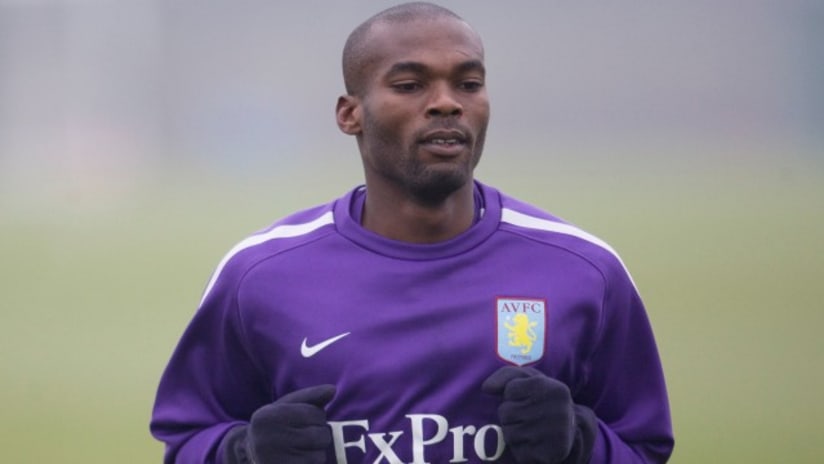Omar Cummings did not need to visit Aston Villa’s famous stadium to understand the importance of the club to their local community. He just took a taxi and everything became clear.
After the 2010 MLS season the Dynamo forward spent a couple of weeks on trial with the English Premier League side, who visit BBVA Compass Stadium on Saturday for this year’s Charities Cup (8 p.m. CT; TICKETS).
The Jamaican was wowed when he saw a match at Villa Park, the club’s home since 1897. “The atmosphere was great, the fans were great—very, very committed fans,” he told reporters at Houston Sports Park on Tuesday.
But the journey made as much of an impression as the destination. Staying in a part of Birmingham filled with Claret and Blue fans—their rivals, Birmingham City, play only three miles away from Villa Park—Cummings took cab rides and realized how ingrained the club was in the fabric of England’s second-largest city.
“One of my fondest memories of being there was riding cabs back and forth to practice every day, getting their views on the team and on the city. Some guys just thanked me so much for [getting to pick] me up so that they could come to Villa Park and the training ground,” said Cummings, who ended up staying with his club at the time, the Colorado Rapids.
“Talking to the cabbies in the morning, the first guy was one of the best—he actually requested, ‘let me pick you up every day.' His father, he didn’t think much of him as a father, but he thanked him for bringing him to a Villa game early in his life, as a kid. He said: ‘we don’t have the best relationship but if I thank him for anything I thank him for that.'”
Supporting Villa is a tradition that goes back many generations. The club was founded in 1874 and became the most successful English team of the Victorian era. They were one of a dozen founder members of the Football League, the world’s oldest soccer league, as well as founder members of the Premier League when it started in 1992.
“No one can doubt their status as one of the institutions who helped to establish soccer in the game's formative years,” said Richard Whitehead, a journalist and author of Children of the Revolution, a history of Aston Villa in the 1970s.
“In Britain this year the centenary of the start of the First World War has become something of a national obsession. At the outbreak of the conflict, Villa were—without question—the most famous football club in the world.
“If the history of soccer interests you and you want to see one of the truly historic clubs in the world in action, then a visit by Villa is not to be missed… Villa more or less invented what it meant to be a big football club—not Real Madrid, Manchester United, Barcelona, Bayern Munich or Liverpool.
“Six of their seven league titles came before the First World War, five of the seven FA Cups. The modern highlight unquestionably came in the early 1980s when the championship was followed by an extraordinary triumph in what we now call the Champions League.”
The club’s best league performances in recent years have been three straight sixth-place finishes from 2008-2010. The past few seasons were far tougher, but Paul Lambert’s side avoided relegation and ended 2013-14 in 15th, ensuring the team will kick off its 27th successive top-level campaign in August.
The Dynamo beat Stoke City 2-0 in last year’s Charities Cup and head coach Dominic Kinnear is looking forward to facing another English Premier League side and the chance to finesse his lineup and tactics without the pressure of having MLS points at stake.
“I enjoy the outside competition, it’s a little bit different, you see something you don’t see either in preseason or during the year,” he said. “These are great teams and great players and guys get up for it in a little bit of a different way. Sometimes it’s a good little break - it’s good to get a break but a working break is good for the players.”
Last Saturday’s 2-2 draw with Toronto FC left the Dynamo ninth in the standings, four points behind the New England Revolution, who currently occupy the fifth and final Eastern Conference playoffs berth. For Kinnear, that gap is both a negative and a positive. It’s a sign that Houston have not yet found consistent form, but it’s far from an unbridgeable gulf considering the team still has 14 regular-season fixtures to play.
“We’ve had some good moments, we’ve had some moments where we’re kind of scratching our heads over the weeks here. I think the level of frustration that we’ve hit, it’s good in a way because the guys are expecting more and that’s what you want come these last 14 games,” Kinnear said.
“We have quality in the locker room, I think we have enough quality to go on a good run and put ourselves in a good spot so we can be contending late in the season.”
Tom Dart is a contributing writer to HoustonDynamo.com and HoustonDashSoccer.com. Former editor and reporter for The Times of London and reporter for SI.com, Dart currently freelances for The Guardian.




